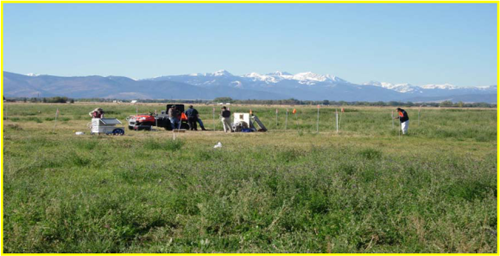Geologic Carbon Sequestration Monitoring
Funding: Department of Energy
Synopsis

Geologic carbon sequestration has been identified as a potential means of reducing the amount of carbon-dioxide (CO 2) emitted into our atmosphere, thereby reducing one of the major contributors to global warming and climate change. A major difficulty with CO 2 sequestration is monitoring sequestration sites and pipelines for leakage. Initial studies of geologic storage sites indicate that leakage rates must be less that 0.1% to 0.01% per year. Moreover, possible CO 2 sequestration leakage is a significant concern for the public at large, who will almost certainly demand stringent monitoring. Likely causes for CO 2 leakage include leaking injection wells, leakage from poorly sealed abandoned wells, and leakage through geologic faults and fractures. These leakage zones may be on the order of 1 m in size and spread over areas on the order of 100’s of square kilometers. Consequently, CO 2 leak monitoring from sequestration sites and pipelines is a difficult problem of massive proportion and huge importance. The CO 2 leakage monitoring technology proposed here utilizes the natural change in reflectance of vegetation as it responds to CO 2 leakage. Detailed studies have shown that plants exhibit stress as soil oxygen is displaced, thereby suffocating the plant roots. This effect changes the reflectance properties of the plants and is a well-known indicator of exposure to underground gas, including methane and CO 2. Since plants cover a large fraction of potential leakage sites, they provide a massive natural array of sensors for CO 2 leakage. To demonstrate proof-of-concept, researchers at Resonon and Montana State University utilized spectral imaging techniques to monitor controlled CO 2 leaks from an underground pipe designed specifically to test CO 2 monitoring technologies. This facility is known as the Zero Emission Research Technology (ZERT) facility. Our research to date clearly demonstrates that vegetation is stressed by underground leakage of CO 2 and that low-cost spectral imaging can be used to identify this stress.
Collaborators
- Rand Swanson - Resonon
- Kevin Repasky - Montana State University
- Rick Lawrence - Montana State University
- Tracy Dougher - Montana State University
- Gabriel Bellante - Montana State University
- Mark Greenwood - Montana State University
Publications
Bellante et al., 2013. International Journal of Greenhouse Gas Control
Vsevolozhskaya et al., 2013. Computational Statistics and Data Analysis
Bellante et al., 2014. PLoS ONE
Vsevolozhskaya et al., 2014. Environmental and Ecological Statistics
